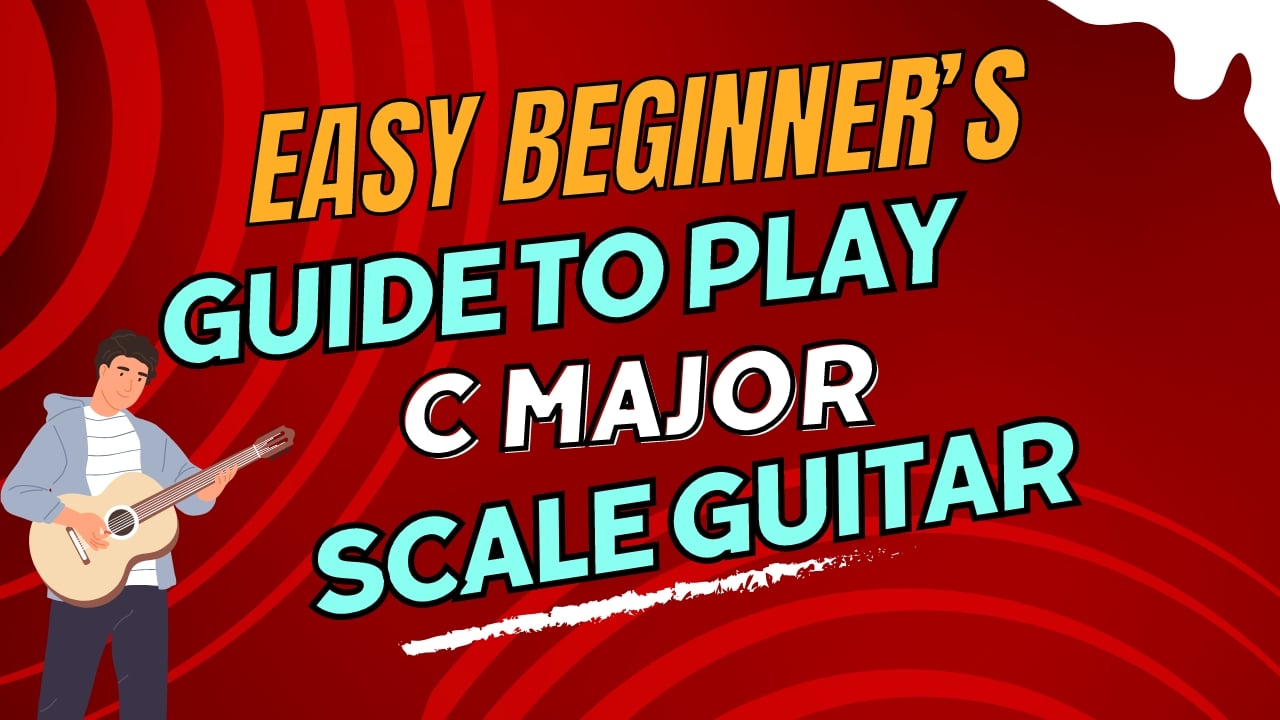- How To Construct C major Scale Formula?
- C Major Scale Formula
- Play C Major Scale on Guitar
- C Major Scale Guitar Fret-board
- C Major Scale Guitar Finger Positions
- Different Positions of C Major Scale
- What is Guitar Chord?
- C Major Scale Guitar Chords Formation
- How to Hold C Major Scale Open Position?
- C Major Scale Guitar Chords
- FAQs
C major scale in guitar, was the first scale, I learnt when I started to play solos. At first looking from outside it seemed tough. But I can easily play with it once I understand the fundamentals of how the scale is constructed.
Almost every instrument player needs to begin with the C major scale chords . It is one of the easiest scales to understand and play. This scale lacks any sharps (#) or flats (♭) and so we call it as a natural scale. Generally Scales in C Major is the most commonly used key in music so it is absolutely critical to master.
At this stage, I expect that you are familiar with Guitar notes and Fretboard. Before playing C major scale I strongly suggest that you take some time to understand the basics, which I have given below.
But first, let’s try and understand what a scale is. It is a group of single notes organised in the order of how high or low it is in pitch. Usually these groups of notes go higher (ascending) or lower (descending) pitch-wise.

Getting a handle, on playing the C Major scale note on the guitar goes beyond memorizing notes; it’s, about aligning your spirit with the truest form of music.
How To Construct C major Scale Formula?
In order to figure out the notes in any scale, one creates a formula using the knowledge of intervals. You can also check this blog for instructions on how to construct major scale. Any of the seven notes in a scale has a distance between them known as an interval.
You can of think of this a distance between any two frets. If any two notes on the guitar are two frets apart, we call the distance between them a tone. However, if they are one fret apart them, we call it as a semi-tone.
Using the concept of intervals, one can formulate a any major scale including the scales in c major. Here’s how we use the concept of tones and semitones to formulate the C major scale chord on guitar.
C Major Scale Formula
Like any other major scale, the scales in c major has seven different notes. Each c major scale notes has a distance from each other measured in tones and semi-tones i.e. the intervals. The formula for creating the scales of c major is ‘tone, tone, semi-tone, tone, tone, tone, semi-tone’.
The image below shows what it looks like on the fret-board if we start from the 1st fret of the 2nd string (the root note) and continue all the way to the 13th fret.
Play C Major Scale on Guitar
We start by playing the note on the 1st fret of the B string (named C, the root note). According to the formula, the 3rd fret (named D) would be a tone apart or two frets higher, which is at .
We can continue following the formula to play the third note, which is also a tone apart, on the 5th fret (named E). The subsequent note would only be a semitone away from the previous note. Hence, we need to play the note on the 6th fret (named F).
The next three C major scale chord notes are a tone apart i.e. on the 8th, 10th and 12th frets respectively (named G, A and B). The last note or the eighth note of the scale is a semitone away from the 12th fret. So, we need to play the 13th fret (also named C) to complete the scales of c major.
C Major Scale Guitar Fret-board
Here’s the tablature of the above C major scale played on the 2nd string. The italic numbers represent the finger numbers of the fretting hand (that holds down the strings on the fret-board).
1 – pointer/index finger
2 – middle finger
3 – ring finger
4 – little finger
Note that the intervals between the third and fourth notes of this scale is a semitone. It is just like the seventh and eighth notes. All other notes have a tone interval between them. This may help to remember the major scale formula a lot easier.
There are other ways to play the scales in c major by using different finger positions. These positions limit the notes to just a couple of frets. Which means, this involves using a smaller area of the fret-board and involves playing multiple strings. Therefore, it is easier to access all the notes in the scale.
C Major Scale Guitar Finger Positions
The different scale positions below don’t always start from the root note (C). They may span across more than one octave. An octave is the difference in pitch between the first and last notes in the scales.
There are numerous finger positions to play the C major scale chord across the fret-board consisting of different octaves. We determined the positions based on the lowest fret , which you can played your notes easily with a fretting hand. Let’s take a look at some of the different scale positions.
Different Positions of C Major Scale
1. C Major Scale – Open Position
The notes for this open position all are in the first three frets and also we will be using open strings. We will also be using only first three fingers to fret the notes to play the notes of C major scale as shown in the diagram.
When playing C major in the open position, you’ll keep your fingers confined to the first three frets. Use your index finger to play the notes on the first fret, your middle finger for notes on the second fret, and your ring finger for notes on the third fret.
Here’s the tablature for the open position:
2. C Major Scale – Second Position
This scale position is a little challenging to play. It has a couple of notes outside the octave we were used to playing in the open position, but utilises all the notes in the C major scale within the 2nd and 6th frets of the fret-board.
To play the notes in this position, we need to move our fretting hand up by one fret so that we can play the notes on the second fret with the index/pointer finger. To play the notes on the 2nd (B) and 1st (high E) strings, we need to move our fretting hand up again by one fret so that we can reach the note on the 6th fret of the 2nd string (B) with our little finger. Here’s the tablature to help us understand more clearly.
3. C Major Scale – Fourth Position
In this position, we will be playing the C major scale across two octaves. The root note (C) of the first octave starts on the 8th fret of the 6th string (E). It ends on the 5th fret of the 3rd string (G).
We have already played these notes in this octave on the previous two positions. But those were on different frets and strings using different fingers. The second octave begins from the same note. It ends on the 8th fret of the 1st string (high E). These notes are higher sounding pitch-wise.
This one is quite difficult to play, but not impossible. Unlike the way we played the preceding scale positions, this one requires the fretting hand to move about freely. It shouldn’t be fixed.
The index, ring and little fingers are required to play the notes on the 5th, 7th and 8th frets on the 6th, 5th and 4th strings. For the notes on the 3rd string, simply move the fretting hand down the neck by one fret to use the pointer, middle finger and little finger to play the 4th, 5th and 7th frets.
After that, we can bring back the hand to the original place to play the rest of the notes on the 2nd and 1st strings as shown in the tablature below.
4. C Major Scale – Seventh Position
The octaves used in this scale position are exactly the same as the ones in the previous scale shape. It involves the same two octaves covered in the preceding scale shape. The notable difference is that the notes on each string here begin from the 7th fret. Except the ones on the 2nd string (B) which start from the 8th fret.
There is no need to move the fretting hand back and forth across the neck. All the notes are quite close by and can be easily accessed. We can use the pointer, middle, ring and little fingers to play the notes on the 7th, 8th, 9th and 10th frets respectively. This is made clear in the following tablature.
5. C Major Scale – Eighth Position
For this position, we start playing from the root note C on the 8th fret of the low E string. It consists of the notes in the same two octaves used in the preceding scale shapes. But, the frets and strings are different from the preceding scale positions based on this, the right fingers need to be used to have better access to these notes.
This position involves a bit of stretching. We need to stretch our fretting hand a little bit to facilitate the use of the little finger. This is to hold down the notes on the 12th frets on the 6th(E) and 5th(A) strings.
For the notes on the 2nd (B) and 1st (high E) strings, we need to position the fretting hand a little higher up the neck of the guitar for the ring and little fingers to access the notes on 12th and 13th frets. The tablature below showing a all finger positions italic numbers.
6. C Major Scale – Twelfth Position
This is the last of all the scale positions in the C major scale chords. The notes in this scale incorporate the use of notes of a much higher octave we’ve yet to come across. Since this involves playing notes on the 12th, 13th, 14th, and 15th frets, naturally the notes in this scale would sound much higher in pitch.
But, we’re dealing with notes of a much higher octave. Therefore playing these notes may not require much stretching of the fretting hand. This is because the distance between the frets on the guitar here are relatively smaller in comparison to the lower frets. However, due to the action of the strings, it may still be quite a challenge to play these notes without a buzz.
As is the case with the other scale positions, we need to use the appropriate fingers of our fretting hand. This will help you to yield a successful result. Tablature with finger numbers (in italics) are provided below.
Interestingly, we can also attempt to play all these scale shapes in reverse! In each of the scale positions, we can try starting from the last note of the 1st string (high E). We then work our way backwards until we get to the note which usually begins on the 6th string (E).
Now we know how to play the C major scale in different positions all over the fret-board. Let’s move on and see how this scale used to create a different notes.
What is Guitar Chord?
Before we get to that, let’s try to understand what a chord is. A chord is two or more musical notes played at the same time which is played by holding down some or all of the strings by the fretting hand.
The picking hand (the hand that plays the strings with a pick) strums some or all of the strings at the same time. This way, we hear multiple notes simultaneously. If you are interested in learning more about guitar chords explore our beginner guitar chords.
C Major Scale Guitar Chords Formation
The C major scale chord is the most commonly used in western music. This chord is formulated using the notes of the C major scale. Namely, C, D, E, F, G, A, B and C again.
So, scales of c major is based on the first three odd numbered intervals from the scale. They are the 1st, 3rd and 5th notes (C, E, and G). This is called a major triad since it mainly consists of 3 notes from the major scale.
So, we use these 3 notes to play the simplest form of the C major scale chord. This is using just one finger to hold it down. All we need to do is put our pointer on the 1st fret of the 2nd string, and then strum the thinnest three strings.

Did You Know?
Have you ever considered that mastering the C scale, on the guitar can improve your finger coordination and lay a groundwork, for grasping music theory?
How to Hold C Major Scale Open Position?
The C major scale diagram and the photo below show how to hold the C major scale guitar chord in the open position with the root note on the 5th string (A).
C Major Scale Guitar Chords
There are other chords that are within the key of C major including the C major scale chord. Let’s see what they are.
1. D Minor Chord
This chord is created in the same way as the C major chord with notes from the D minor scale. The 1st, 3rd and 5th notes in this D minor chord are D, F and A, which are played together creating this minor triad. Here’s a chord diagram to show us how to hold this chord in the open position on the fret-board using just the top 4 strings.
2. E Minor Chord
This is probably the easiest chord to play. The E minor chord only requires us to use two fingers to hold down the 2nd fret on the 5th (A) and 4th (D) strings. The rest of the strings are open and all the strings are strummed by the picking hand. Check out the chord diagram which shows how easily this chord can be played.
3. F Major Chord
Just like the previously discussed chords, the F chord is also created similarly. It is created using the 1st, 3rd and 5th notes of the major scale (F, A and C). This is also a major triad. This chord can be challenging to play at first. It involves flattening the pointer/index finger to hold down the first two strings at the same time. Here’s the chord diagram that clearly illustrates how to hold this chord.
4. G Major Chord
Another interesting chord is the G major chord, which is also extensively used and quite easy to play. It involves the use of three distinct notes G, B and D which are the 1st, 3rd, and 5th notes of the G-major-scale. So this is also a triad based on the related major scale. Here we have the chord diagram which shows us the chord.
5. A Minor Chord
The A minor chord is the relative minor of the C major chord. It uses the notes A, C and E according to the minor triad formula. Comparatively, this is also one of the easier chords to play on the guitar. Check out the image here to better understand how to play this chord.
6. B Diminished Chord
This chord does have a different name. This is owing to the fact that the 3rd and 5th notes of this triad are a semitone lower (flatter-♭) than it should be. The three notes that constitute the B diminished chord are B, D and F. It’s quite a tricky chord to hold down. Using a combination of these notes on the guitar, this is how it’s played across the 5th, 4th, 3rd and 2nd strings.
Final Thoughts
In order to practice these chords, we must try holding down each chord first. Both with our fretting hand and with the picking hand, we must pick each string (including the open strings). This is done to check if it’s getting muted or if there’s a buzzing sound. Next, we must try switching between different chords. We have to make sure we don’t mute the strings and try to get a clean sound.
It goes without saying that the only way to truly master the above-mentioned chords and scales. Dedicated practice every day with the help of a metronome. We should start at a really slow speed (like 40-60 BPM) until we’re fairly confident enough to play them properly. After which gradually increasing the speed to about 80-100 BPM or faster.
Want to improve your Guitar playing skills? Learn to play following Guitar Scales.
FAQs
What is the C major chord?
It’s a commonly played open chord shape on the first few frets of the guitar. The ring, middle and index fingers are pressed against the 5th, 4th and 2nd strings on the 3rd, 2nd and 1st frets.
What are some common mistakes beginners make with the C chord?
Here are a few common mistakes to look out for when playing the C Major chord:
- The pointer on 2nd string touches either the open 3rd string or the open 1st string, causing those strings to buzz or mute completely.
- The middle and ring fingers don’t press the string enough, causing a dead note or a muted sound.
- The palm of the hand behind the guitar neck is too close. Hence, the fingers don’t have enough pressure to hold down the strings causing buzzed or muted sounds.
- This chord is only played across 5 strings, starting from the 5th string. Most beginners play all 6 strings, which makes it sound odd.
How can I transition smoothly between the C chord and other chords?
Here’s a few ways to easily shift between the C major chord and the other chords:
- Minimize finger movement between different chord positions.
- Place your fingers on the lower strings first before placing the other fingers on the other strings.
- Find the common fret used for the C major chord and any other open chord and try to keep that finger in the same place, while moving the other fingers to play the next one.
What is the theory behind the C major chord?
All major chords, like the C major chord are made up of 3 notes of the major scale- the 1st , 3rd and 5th notes. For the C major scale, these notes are C, E and G. A combination of these three notes across different octaves make the C major chord.
What songs use the C major chord on guitar?
Here are a few songs that use the C major chord in the open position:
- Thamizha Thamizha – Roja
- Enthan Kan Munne – Nanban
- Newyork Nagaram – Sillunu Oru Kaadhal
- Give Me Some Sunshine – 3 Idiots
- Maa – Taare Zameen Par
- Kal Ho Naa Ho – Kal Ho Naa Ho
- Ho Hey – The Lumineers
- Let It Be – The Beatles
- All I Want – Kodaline
- Pluto Projector – Rex Orange County
































